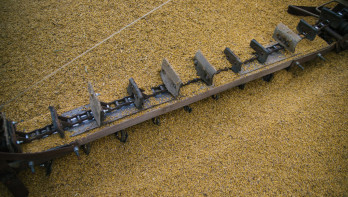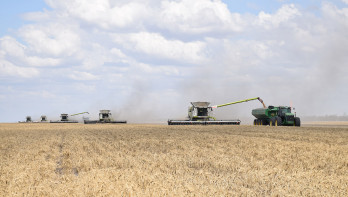Analysis Grains
Wheat in Central Europe Falling Behind Due to Drought
On the Matif, the past trading session marked the end of the decline in wheat, with the March contract closing with a small gain. Possibly, the new export forecast for Russian wheat exports gave the market some confidence. This winter is certainly not as extreme as the previous one, but that doesn't mean that the wheat has emerged from winter unscathed. Both an excess and a shortage of water are causing problems in the EU. Trump caused unrest on the Chicago exchange by bringing import duties for Canada and Mexico to the forefront.
The March wheat contract on the Matif showed a modest gain yesterday, closing €0.50 higher at €225 per ton. Grains on the CBoT closed in the red. Wheat was the biggest decliner, losing 1.1% to close at $5.72¾ per bushel. Corn closed 0.6% lower at $4.79¾ per bushel. Soybeans closed in the green on the Chicago exchange with a 0.2% increase to $10.31¼ per bushel.
Wheat exports from the EU are not really picking up. Up to February 23, 13.65 million tons of wheat have been exported compared to 21.31 million tons the previous year. SovEcon reduced the export estimate for Russia in the 2024/25 season by 600,000 tons to 42.2 million tons. For the upcoming season, the market bureau actually increased the export compared to their previous forecast. SovEcon estimates that Russia will export 38.9 million tons of wheat in 2025/26, up from 38.3 million tons in the previous forecast.
Too wet or too dry
Winter wheat for the upcoming harvest in Europe is not looking good everywhere. In the northwest of France, a combination of wet and cool weather is hindering the development of winter grains, as reported in the February edition of the Mars bulletin by the JRC. In a broad strip across central and eastern Europe from Poland to Bulgaria, drought is a problem according to the scientific bureau of the European Commission. Besides the lack of moisture in the soil, there is also little snow cover to protect the crops in case it gets really cold at the end of winter. The JRC anticipates that a portion of the winter grains in this region may need to be replanted next spring.
In eastern Ukraine, winter grains are also developing moderately. They were sown under dry conditions, making it difficult for the wheat to establish. Since then, the moisture deficit has not been replenished. Similar to central and eastern Europe, there is also little snow, increasing concerns about winterkill. This edition of the Mars Bulletin highlights Northwest Africa. Morocco and western Algeria are experiencing dry conditions. In northern Morocco, this winter is the third driest since 1991. It is also the sixth consecutive year with a significant winter precipitation deficit. Temperatures are around the long-term average, except for the last 10 days of January when it was significantly warmer.
Import duty as early as next week
Concerns arose on the Chicago exchange over the import duties threatened by Trump. After the import date for a 25% duty on products from Canada and Mexico was postponed from early February to March 4, tensions eased and various sources believed there would be another extension. Yesterday, the president stated that 'the tariffs will be implemented on time and as scheduled.' According to an anonymous source from the U.S. government cited in various media outlets, it is by no means certain that the duty will be imposed in March. This depends, among other things, on border security, to which the import duties are linked.
Brazilian farmers have made good progress in the soybean harvest. According to AgRural, 39% of the area has been harvested. Last week, it was at 23%, and at the same time last year, 40% of the soybeans had been harvested. The higher temperatures and sufficient dry days worked in favor of the farmers. Planting of the next crop, corn, is 64% complete. Last week it was at 36%, but by this time last year, 73% of the planned corn area had been sown.




